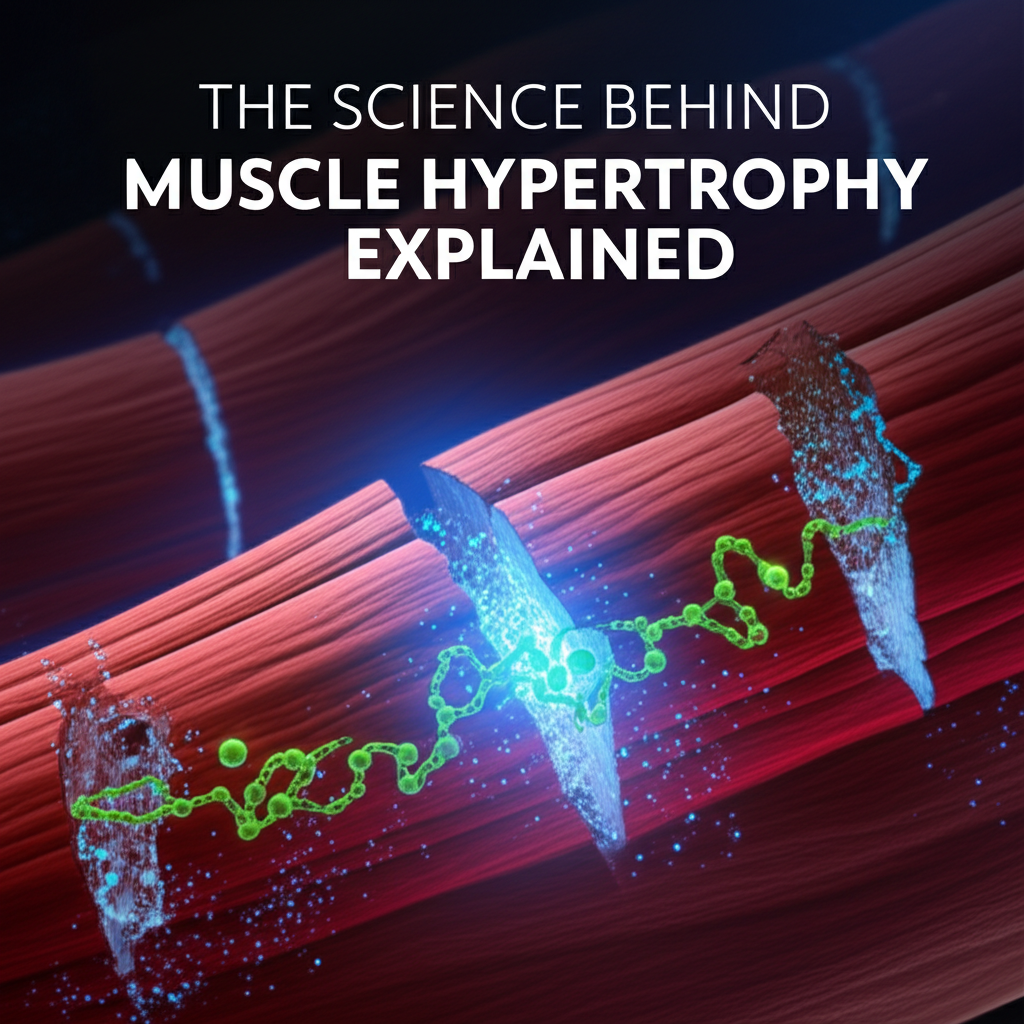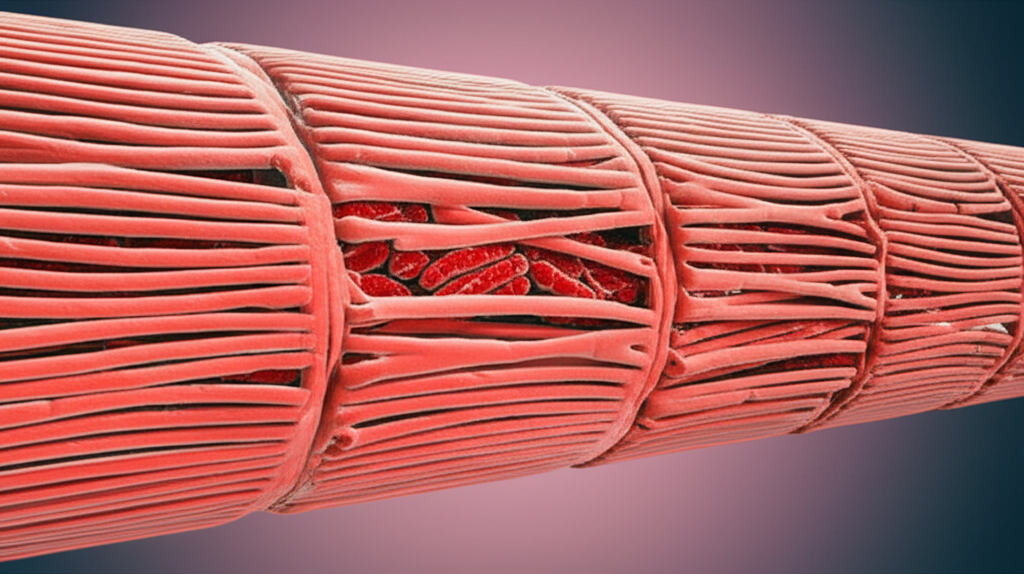The Science Behind Muscle Hypertrophy Explained

Muscle hypertrophy is the process of building bigger, stronger muscles through controlled damage and repair. It’s a fascinating science driven by mechanical tension, muscle damage, and metabolic stress, leading to increased muscle size and strength.
Key Takeaways

- Understand how muscle fibers grow stronger and larger.
- Learn the three main triggers for muscle hypertrophy.
- Discover the role of resistance training in muscle growth.
- Grasp the importance of nutrition and recovery for results.
- Build bigger muscles with science-backed knowledge.
Have you ever wondered how athletes and fitness enthusiasts build impressive muscles? You see them in the gym, lifting weights and looking stronger, and you might think it’s just about sheer effort. But there’s a fascinating scientific process happening beneath the surface: muscle hypertrophy. This term might sound complex, but it essentially means your muscles are getting bigger and stronger. Many find the exact science behind it a bit confusing, but don’t worry! This guide will break down the science behind muscle hypertrophy in a simple, step-by-step way, helping you understand how to achieve your muscle-building goals effectively.
The Science Behind Muscle Hypertrophy Explained: How Muscles Grow Bigger
Muscle hypertrophy is the magical word for how your muscles increase in size. It’s not just about getting more muscle fibers; it’s primarily about making your existing muscle fibers thicker and stronger. Think of your muscle fibers like tiny threads. When you challenge them through exercise, especially resistance training, you create microscopic tears. Your body then repairs these tears, making the fibers not only whole again but also a bit bigger and more robust. This adaptation is your body’s clever way of preparing for future challenges.
This process is a cornerstone of strength training and bodybuilding. Understanding it can help you train smarter, not just harder. We’ll explore the primary mechanisms that drive this growth, the types of training that encourage it, and how your daily habits play a crucial role. Ready to unlock the secrets to building bigger muscles?
Understanding Muscle Fibers: The Building Blocks of Strength
Before diving into how muscles grow, it’s helpful to know what muscles are made of. Skeletal muscles, the ones responsible for movement, are composed of long, fibrous cells called muscle fibers. These fibers are bundled together and work in unison to produce force.
There are two main types of muscle fibers:
- Type I (Slow-Twitch) Fibers: These are endurance fibers. They are good at sustained, lower-intensity activity, like running a marathon. They are more resistant to fatigue but don’t produce as much force or grow as large as Type II fibers.
- Type II (Fast-Twitch) Fibers: These are power fibers. They are excellent for short bursts of intense activity, like sprinting or lifting heavy weights. Type II fibers have a greater potential for hypertrophy, meaning they can grow significantly larger when stimulated properly.
Most muscles in your body contain a mix of both fiber types, but the ratio can vary depending on the muscle and your training history. For muscle hypertrophy, stimulating Type II fibers is key, as they respond most dramatically to strength training.
The Three Pillars of Muscle Growth: Triggers for Hypertrophy
Scientists generally agree that three main factors contribute to muscle hypertrophy. When you engage in challenging physical activity, your body responds by initiating these growth processes. These are the core scientific principles you’ll want to keep in mind when designing your training.
1. Mechanical Tension: The Most Crucial Driver
Mechanical tension is the force exerted on your muscle fibers during resistance exercise. When you lift a weight, your muscles contract against that resistance. The heavier the weight or the more challenging the resistance, the greater the tension on the muscle fibers. This tension signals to the muscle that it needs to become stronger and larger to handle such loads in the future.
Think of it like stretching a rubber band. The more you stretch it, the more it pulls back. Similarly, when your muscle fibers are under high tension, they experience cellular events that lead to growth. To maximize mechanical tension, focus on:
- Lifting challenging weights that allow you to complete your target repetitions with good form.
- Controlling the movement, especially during the eccentric (lowering) phase of an exercise.
- Varying exercises to hit the muscle from different angles and create tension throughout its full range of motion.
Research published in the Journal of Strength and Conditioning Research highlights that mechanical tension is a primary stimulus for muscle protein synthesis, the process of creating new muscle proteins that lead to bigger fibers.
2. Muscle Damage: The “Soreness” Signal
When you perform strenuous exercises, especially those that are new or particularly intense, you create microscopic tears in your muscle fibers. This is often referred to as “exercise-induced muscle damage” (EIMD). You might feel this as muscle soreness (delayed onset muscle soreness, or DOMS) a day or two after a tough workout.
While soreness can be an indicator that you’ve challenged your muscles, it’s important to note that significant pain is not necessary for growth. The damage itself, however, acts as a significant signal to your body. Your body’s repair process kicks in, not only fixing the damaged fibers but also making them slightly larger and more resilient to prevent future damage. This repair process involves satellite cells, which are muscle stem cells that fuse with existing muscle fibers to help repair and rebuild them.
It’s a delicate balance: enough damage to stimulate repair and growth, but not so much that it hinders your ability to train consistently. Overtraining and excessive damage can lead to injuries and stalled progress.
According to a review in Sports Medicine, muscle damage, particularly when combined with other stimuli, plays a role in initiating the hypertrophic response by activating cellular pathways that promote muscle repair and growth.
3. Metabolic Stress: The “Pump” Effect
Metabolic stress occurs when your muscles work intensely for a sustained period, leading to the buildup of metabolic byproducts like lactate, hydrogen ions, and inorganic phosphate. This often results in that “burning” sensation and the feeling of a “pump” during a workout. While this pump feels good, it’s also a signal for muscle growth.
The buildup of these metabolites can trigger several cellular responses that contribute to hypertrophy. It’s thought to increase satellite cell activation and release growth factors that can promote muscle protein synthesis. Performing higher repetitions with shorter rest periods, often used in bodybuilding routines, is very effective at inducing metabolic stress.
To maximize metabolic stress:
- Perform higher repetition ranges (e.g., 10
